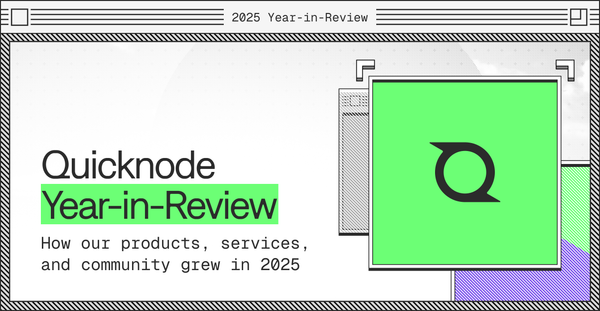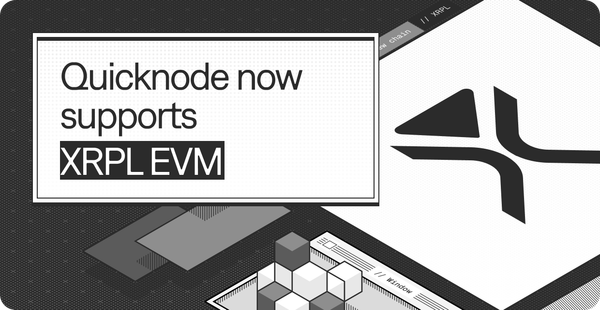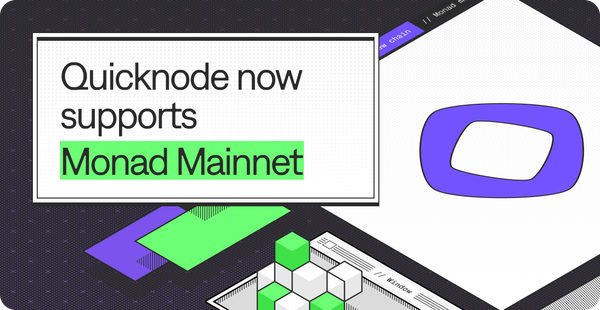The Evolution of Blockchain RPCs: The Backbone of Web3 Data
Discover how QuickNode’s suite of tools—Streams, Filters, and Functions—streamlines blockchain data management and enhances the performance of your dApp with real-time insights, scalability, and custom logic execution.

Nodes are critical infrastructure, enabling seamless interactions with blockchain networks. The methods to manage them have evolved with time as dApps have grown in complexity and the volume of blockchain data has increased. We’ve gone from self-hosted nodes, to dedicated node provider services like QuickNode.
Today, the evolution has progressed to comprehensive Extract, Transform, Load (ETL) solutions that source, deliver, filter, customize, and even act on the data.
This piece will explore the RPC evolution, the pain points each step solves, and how QuickNode has adapted and advanced this evolution.
What is a Blockchain Remote Procedure Call (RPC)?
RPC (Remote Procedure Call) is a protocol that enables dApps or users to interact with blockchain nodes, allowing them to request services like querying data, sending transactions, and retrieving information.
To make an RPC call, the client sends a request to a blockchain node via RPC endpoints using the JSON-RPC protocol. Then, an RPC node, whether public, self-hosted, or provided by a service like QuickNode, processes the request and returns the requested data, a transaction hash, or an error message.
RPC API vs RPC Node: Understanding the Differences
RPC nodes and APIs might sound interchangeable as they’re both essential to interacting with blockchain networks. However, this is not the case; both serve complementary functions but operate on different levels of the blockchain infrastructure.
Now, let's break down the key differences between RPC APIs and RPC nodes.

Understanding this difference helps developers decide whether to prioritize ease of use and scalability (RPC API) or control and customization (RPC node).
QuickNode offers both RPC services and API solutions that allow developers to build scalable dApps without worrying about node management complexities.
QuickNode RPC
- Dynamic scaling: Our infrastructure automatically adjusts to handle varying levels of demand.
- Globally Distributed Nodes: We have a globally distributed network of nodes across 30+ blockchains.
- High Reliability and Uptime: We ensure applications remain operational even under heavy demand with a 99.99% uptime guarantee.
QuickNode API
- Managed infrastructure: We handle all blockchain node maintenance, including forks and upgrades.
- Built-in security: We offer features like token-based authentication, referrer whitelisting, and domain masking to ensure secure API access.
- Real-time analytics and monitoring: We provide detailed usage statistics and metrics to track API calls, performance, and resources across blockchains.
Evolution of Blockchain RPCs
As dApps become more complex, the way we interact with blockchains has also changed significantly. Let’s explore how RPCs have evolved, from the early stages of public RPC endpoints to the advanced ETL solutions.
Self-hosted Nodes: Maintain and Run Your Own Node
All blockchains come with a set of public RPC endpoints that allow users to interact with the blockchain. However, these aren’t suitable for dApps, as they have limited bandwidth, slower response times, and restrictions on the number of requests they can handle.
So, developers and organizations turned to self-hosted RPC nodes, enabling them to run their own infrastructure and manage private endpoints. This allowed for direct communication with the blockchain but came with its own set of benefits and drawbacks.
Benefits of self-hosted RPC nodes
- Full control: Developers have complete control over configuration, security, and performance.
- Data sovereignty: Self-hosted nodes ensure that all blockchain data is stored and managed within a private infrastructure.
- Enhanced security: Self-hosted nodes offer the flexibility to implement and optimize their own security protocols.
Drawbacks of self-hosted RPC nodes
- High resource demands: Maintaining a self-hosted node requires significant hardware, including storage, processing power, and bandwidth, leading to high operational costs.
- Synchronization issues: Nodes can fall out of sync during network upgrades or high transaction volumes, affecting data accuracy and causing downtime.
- Constant updates: Regular updates for software, security patches, and new features are essential to avoid vulnerabilities and ensure compatibility, increasing maintenance efforts.
Given these challenges, it became difficult for developers and organizations to manage self-hosted RPC nodes. So, they turned to more efficient solutions, such as Nodes as a Service.
Nodes as a Service (NaaS): Employ Fully-Managed Node Infrastructure
NaaS solution providers allow developers and organizations to use fully managed blockchain nodes without the need to set up or maintain their own infrastructure.
They handle everything from node setup, maintenance, and scaling, to synchronization, allowing developers to focus on building and deploying dApps. But they’re only ideal for dApps that don’t require advanced data management and real-time analytics. Let's explore their benefits and limitations further.
Benefits of using NaaS providers
- Eliminates maintenance burdens: NaaS providers like QuickNode take care of all aspects of node maintenance, including software updates, security patches, and synchronization. This enables developers to focus on dApp development instead of worrying about infrastructure management.
- Enhances node reliability: Node management services offer highly available, scalable, and well-maintained infrastructure that ensures decentralized applications (dApps) remain operational and responsive. Quicknode’s RPCs, for instance, offer a 99.9% uptime guarantee, which means developers no longer have to worry about unexpected node failures, synchronization issues, or downtime that could disrupt their dApp’s functionality.
- Improves scalability: NaaS solutions can handle the growing transaction volumes and data queries of a dApp by distributing RPC requests across multiple nodes, dynamically scaling infrastructure.
QuickNode’s Smart Global RPC Load Balancer helps with scaling by distributing RPC requests across multiple nodes. This ensures that the dApp can handle increasing traffic loads without being bottlenecked by a single node.
While NaaS providers are beneficial, they may limited to sourcing and delivering data. QuickNode has pushed the boundaries with its suite of ETL solutions.
ETL Solutions: Real-Timereal-time Data Streaming in a Ready-to-use Format
ETL (Extract, Transform, Load) is a process that enables the collection, processing, and delivery of blockchain data in a ready-to-use format.
This involves pulling raw data from blockchain nodes, transforming it into usable formats, and delivering it to applications in real-time. It’s essential for dApps that need to make sense of vast amounts of data and turn it into actionable insights quickly and efficiently.
Benefits of blockchain ETL solutions
- Data relevancy: With QuickNode ETL solutions, the extraction of data from multiple sources can be standardized, transformed, and loaded to a dApp's backend, automatically. This brings about data consistency and relevancy.
- Scalability: QuickNode ETL is embedded with dynamic scaling, allowing businesses to handle larger and more distinct data sets with ease.
- Better developer experience: With easy-to-deploy data pipelines, QuickNode ETL makes it easier for dApps and blockchain solutions to get their data management systems in place, meaning faster development.
Apart from this, ETL solutions reduce the need for extensive in-house infrastructure and maintenance, saving costs for dApps. Also, with data optimized for relevance and delivery, ETL solutions also mean higher performance.
Why QuickNode's ETL Tools are the Ultimate Solution for Blockchain Data Management
QuickNode offers one of the most robust and comprehensive ETL solutions in the blockchain space. Our suite of tools—Streams, Filters, and Functions— support 17+ blockchain networks and are equipped to streamline data management for dApps. Here’s how:
- QuickNode Streams provides real-time data streaming, ensuring that applications have instant access to up-to-the-second blockchain events. This makes QuickNode ideal for applications that need fast, actionable data, such as DeFi platforms or NFT marketplaces running live auctions.
- QuickNode Filters allows for custom filtering, ensuring that only relevant data is retrieved, thereby reducing system load and improving efficiency. With this tool, developers can easily tailor their data extraction to meet the unique needs of their dApp without wasting time on irrelevant blockchain events.
- QuickNode Functions offers edge functions that offer low-latency execution of logic, ideal for web3 apps requiring real-time responsiveness. With data pipelines and execution functions deployed in one setup by QuickNode, it brings out benefits like higher performance, custom logic execution, and reliability.
Closing Thoughts: Self-Hosted vs Dedicated Nodes vs ETL Solutions — Which Should You Choose?
RPCs have evolved tremendously over time, from simple public endpoints to advanced solutions that offer real-time data processing and scalability. Initially, developers used self-hosted nodes, then shifted to NaaS providers for easier management.
Now, ETL solutions like QuickNode’s go one step further offering real-time data extraction, custom filtering, and advanced analytics, providing the best balance of scalability and efficiency. However, the right solution for your dApp will depend on factors like scalability, cost, security, and performance requirements.

About QuickNode
QuickNode is building infrastructure to support the future of Web3. Since 2017, we've worked with hundreds of developers and companies, helping scale dApps and providing high-performance access to 40+ blockchains. Subscribe to our newsletter for more content like this, and stay in the loop with what's happening in web3!





